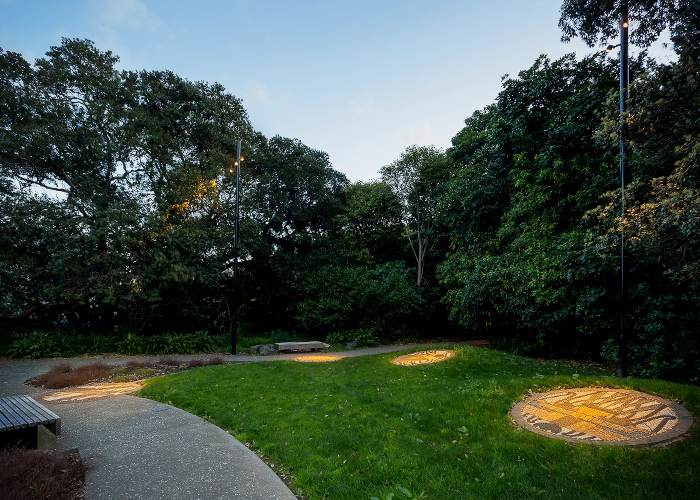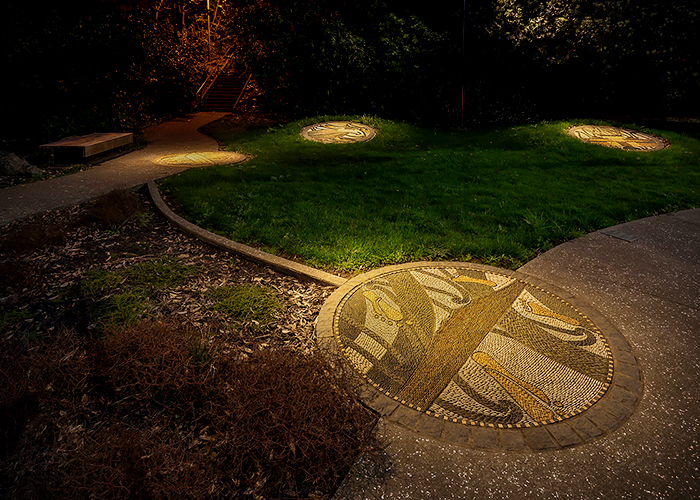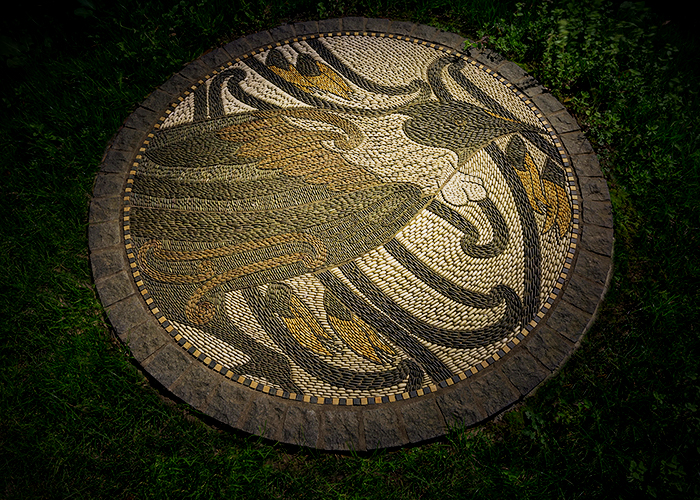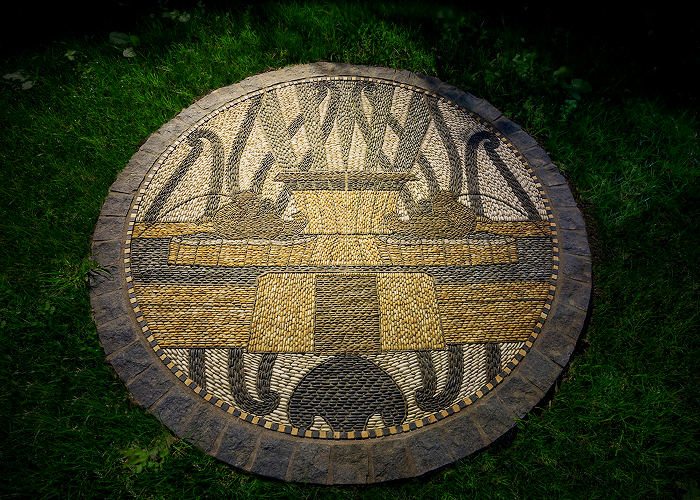Lighting Design Turns Artwork Into Nocturnal Landmark by WE-EF The artwork, He Turanga Hou; a new place of reflection - by Graham Tipene and John Botica - is part of an upgrade to the Mission Bay entry to Bastion Point. Lighting design makes NZ artwork a nocturnal landmark When Auckland Council commissioned the lighting design for a new artwork at the base of the steps from Tãmaki Drive to Takaparawhau Bastion Point, little did they know it would produce a nocturnal landmark. The artwork, He Turanga Hou; a new place of reflection - by Graham Tipene and John Botica - is part of an upgrade to the Mission Bay entry to Bastion Point. The improvements to the area resulted in the creation of a boutique park area that included new paths, landscaping as well as the addition of two new seats and decorative rocks. However, the key feature of the area is the artwork, which consists of five large circular mosaic "medallions" made of naturally coloured pebbles.  The artwork, He Turanga Hou; a new place of reflection - by Graham Tipene and John Botica - is part of an upgrade to the Mission Bay entry to Bastion Point. According to Auckland Council, the lighting designed especially for the work by Light Works is a key feature of its success. "Auckland Council's brief to Light Works was to create a lighting result that would highlight the five mosaic medallions in a dramatic way and which would also emphasise their colour and texture," said Tracey Williams, head of creative strategy at Auckland Council. "We also wanted the lighting to provide orientation for pedestrians using the footpath as well as interest for people at the adjacent bus stop. There has been positive feedback from the local Mission Bay community in relation to this project. This small installation has also become a nocturnal landmark," added Ms Williams. The steps are a threshold to Takaparawhau Bastion Point, a significant Auckland location that sits within Whenua Rangatira, an area of land with deep spiritual and cultural significance set aside as a reserve for the benefit of the Hapū and people of Auckland.  The desire was to have all five medallions looking the same while not being able to see where the light was coming from. "This has a direct physical relationship with the Õrakei Block, which contains the Takaparawhau Marae and is the recognised turangawaewae* of Ngãti Whãtua Õrakei," said Ms Williams. In conjunction with WE-EF sales partner Mark Herring Lighting, lighting design consultants Light Works delivered a lighting concept for the project that specified five FLC121 projectors with snoots. The five medallions were placed at random locations within the small triangular area. Two of the medallions were mounted on mounds at a sloping angle so they could be seen more clearly from Tamaki Drive. As Tamaki Drive is a busy highway and the area is located immediately adjacent, care had to be taken to avoid any spill light and glare reaching the carriageway.  The artwork. The desire was to have all five medallions looking the same while not being able to see where the light was coming from. It was also important to ensure that any equipment was discrete during the day and did not encroach into the central grassed area. "The lighting concept was to mount the lighting equipment on poles that were high enough to keep aiming angles down but low enough to provide texture on the art itself," said Richard Bracebridge, principal designer at Light Works. "Very narrow beam luminaires were needed to pinpoint the artworks. Snoot accessories were added to provide glare control and contain unwanted spill. To test the lighting concept, an AGI model was created and sample products assessed for their performance and ease of installation," he said. The five medallions are illuminated with five WE-EF FLC121 projectors - each 12 W, 'sharp cut-off' distribution, 3000 K. These luminaires have remote IP65 control gear located in the base of the poles to keep the products' body size to a minimum. The projectors were mounted on two 8.5 m poles located outside the main entries' lawn area and outside the new paths. The poles' positions were designed exactly in relation to the individual medallion locations that each luminaire was tasked with illuminating, which meant that the poles could be pre-drilled and tapped in the manufacturing process prior to their pre-paint treatments. The combination of the black-painted pole, small black projectors with snoots and tight beam control makes the lighting equipment barely visible after dark. The whole installation is controlled by a daylight/time clock, allowing the switching on 30 minutes prior to sunset and off 30 minutes after sunrise. *Turangawaewae is one of the most well-known and powerful Mãori concepts. Literally turanga (standing place) and waewae (feet), it is often translated as "a place to stand." Trangawaewae are places where Mãori people feel especially empowered and connected - locations that are their foundation, their place in the world, their home. Photos courtesy of Mark Herring Lighting.
|
03 8587 0400 6/13 Downard Street, Braeside, Vic, 3195
|


 Modern Catenary Solution Fit for
Modern Catenary Solution Fit for WE-EF's New Managing Director for
WE-EF's New Managing Director for A New Era for WE-EF LIGHTING – A Home
A New Era for WE-EF LIGHTING – A Home Myers Park Lighting Upgrade:
Myers Park Lighting Upgrade: Bridging the Past and Future: Old Murray
Bridging the Past and Future: Old Murray WE-EF Profile Projectors for Sharper
WE-EF Profile Projectors for Sharper Award-winning Bay Pavilions, Arts +
Award-winning Bay Pavilions, Arts + Enhancing Transit Experience at Byron
Enhancing Transit Experience at Byron Intelligently Illuminating the Bay Run
Intelligently Illuminating the Bay Run WE-EF Lighting's Role in Protecting
WE-EF Lighting's Role in Protecting Sustainable LED Upgrade Kit from WE-EF
Sustainable LED Upgrade Kit from WE-EF A Natural Paradise Rottnest Island by
A Natural Paradise Rottnest Island by WE-EF LIGHTING's Braeside Expansion
WE-EF LIGHTING's Braeside Expansion Street and Area Pole-Mounted Luminaires
Street and Area Pole-Mounted Luminaires Smart Lighting Control Technology from
Smart Lighting Control Technology from High-Output Floodlights with Modern LED
High-Output Floodlights with Modern LED Bondi Beach Pavilion Reimagined by WE-EF
Bondi Beach Pavilion Reimagined by WE-EF Balancing Needs: Sea Turtle Conservation
Balancing Needs: Sea Turtle Conservation Architecturally Pleasing Recessed
Architecturally Pleasing Recessed Luminaires for Lake Macquarie Multi-Arts
Luminaires for Lake Macquarie Multi-Arts
